
- •Preface to the First English Edition
- •Contents
- •1 Biology of the Cell
- •2 Genetics and Evolution
- •3 Tissues
- •4 The Locomotor System (Musculoskeletal System)
- •5 The Heart and Blood Vessels
- •6 Blood, the Immune System, and Lymphoid Organs
- •7 The Endocrine System
- •8 The Respiratory System
- •9 The Digestive System
- •10 The Kidneys and Urinary Tract
- •11 The Reproductive Organs
- •12 Reproduction, Development, and Birth
- •13 The Central and Peripheral Nervous Systems
- •14 The Autonomic Nervous System
- •15 Sense Organs
- •16 The Skin and Its Appendages
- •17 Quantities and Units of Measurement
- •Index
- •Anterior view of the human skeleton
- •Posterior view of the human skeleton
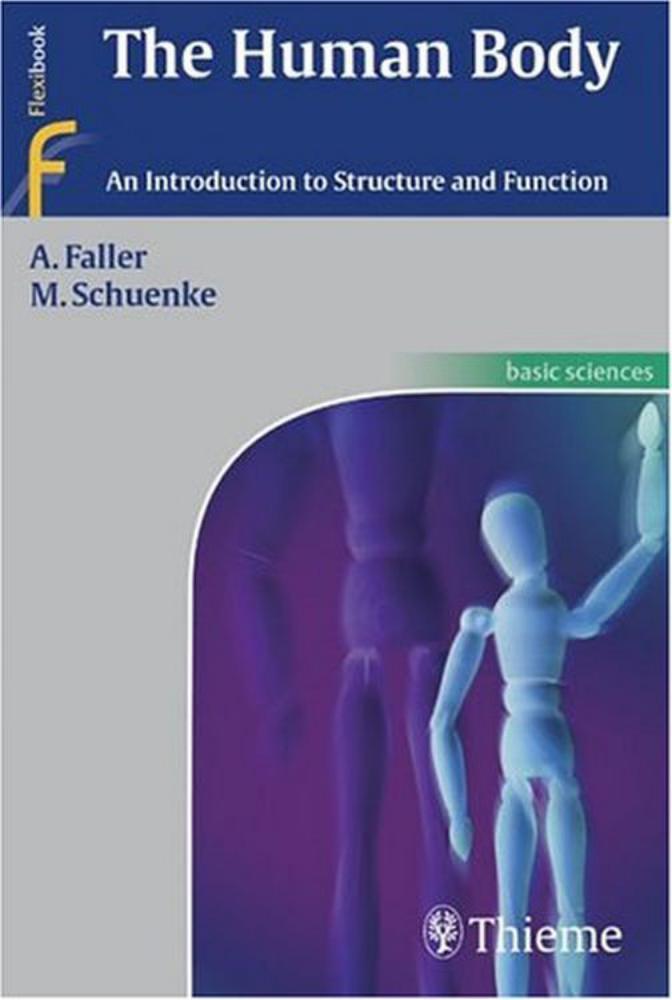

Contents III
The Human Body
An Introduction to Structure and Function
Adolf Faller, M.D.
Former Professor
University of Fribourg
Fribourg, Switzerland
Michael Schünke, M.D., Ph.D.
Professor
Institute of Anatomy CAU Kiel
Kiel, Germany
Gabriele Schünke, M.Sc.
Dipl.-Biol.
Kronshagen, Germany
Translated by Oliver French, M.D.; edited by Ethan Taub, M.D.
316 colored illustrations
Thieme
Stuttgart · New York
http://www.bestmedbook.com/

IV Contents
Library of Congress Cataloging-in-Publication Data is available from the publisher
This book is an authorized and revised translation of the 13th German edition published and copyrighted 1999 by Georg Thieme Verlag, Stuttgart, Germany. Title of the German edition: Der Körper des Menschen: Einführung in Bau und Funktion
Translator: Oliver French M.D., Brooktondal, NY,
USA
Editor: Ethan Taub, M.D., Diplomate of the American Board of Neurological Surgery, Klinik im Park, Zürich, Switzerland
1st Dutch edition 1970 2nd Dutch edition 1974 3rd Dutch edition 1978 4th Dutch edition 1981
1st French edition 1970 2nd French edition 1983 3rd French edition 1988 4th French edition 2000
1st German edition 1966 2nd German edition 1967 3rd German edition 1969 4th German edition 1970 5th German edition 1972 6th German edition 1974 7th German edition 1976 8th German edition 1978 9th German edition 1980 10th German edition 1984 11th German edition 1988 12th German edition 1995
1st Italian edition 1973
1st Japanese edition 1982 2nd Japanese edition 1993 3rd Japanese edition 1998
1st Spanish edition 1968 2nd Spanish edition 1984
© 2004 Georg Thieme Verlag, Rüdigerstrasse 14, 70469 Stuttgart, Germany http://www.thieme.de
Thieme New York, 333 Seventh Avenue, New York, NY 10001 USA http://www.thieme.com
Cover design: Cyclus, Stuttgart Typesetting by primustype Hurler GmbH, Notzingen
Printed in Germany by Grammlich, Pliezhausen
ISBN 3-13-129271-7 (GTV) |
|
ISBN 1-58890-122-X (TNY) |
1 2 3 4 5 |
Important note: Medicine is an ever-changing science undergoing continual development. Research and clinical experience are continually expanding our knowledge, in particular our knowledge of proper treatment and drug therapy. Insofar as this book mentions any dosage or application, readers may rest assured that the authors, editors, and publishers have made every effort to ensure that such references are in accordance with the state of knowledge at the time of production of the book.
Nevertheless, this does not involve, imply, or express any guarantee or responsibility on the part of the publishers in respect to any dosage instructions and forms of applications stated in the book. Every user is requested to examine carefully the manufacturers’ leaflets accompanying each drug and to check, if necessary in consultation with a physician or specialist, whether the dosage schedules mentioned therein or the contraindications stated by the manufacturers differ from the statements made in the present book. Such examination is particularly important with drugs that are either rarely used or have been newly released on the market. Every dosage schedule or every form of application used is entirely at the user’s own risk and responsibility. The authors and publishers request every user to report to the publishers any discrepancies or inaccuracies noticed.
Some of the product names, patents, and registered designs referred to in this book are in fact registered trademarks or proprietary names even though specific reference to this fact is not always made in the text. Therefore, the appearance of a name without designation as proprietary is not to be construed as a representation by the publisher that it is in the public domain.
This book, including all parts thereof, is legally protected by copyright. Any use, exploitation, or commercialization outside the narrow limits set by copyright legislation, without the publisher’s consent, is illegal and liable to prosecution. This applies in particular to photostat reproduction, copying, mimeographing, preparation of microfilms, and electronic data processing and storage.

Contents V
Preface to the First English Edition
The first German edition of this book, which was later lovingly known as “The Faller,” published in 1966. At this time nobody could ever have imagined that “The Human Body,” written by Swiss anatomist Adolf Faller, would remain uniquely successful for almost 40 years. Thirteen German editions and several editions in other languages speak for themselves. Fifteen years after Faller’s death, the thoroughly and extensively revised 13th German edition published. The current English edition is based upon this German edition.
The new version contains almost 200 more pages than the original. In addition, more than 50 new illustrations have been added to facilitate an easier approach to sometimes difficult information. Where necessary, entire chapters have been rewritten to cover the latest developments in human biology and medicine. All these changes have been made with the reader in mind. In fact, many of the changes were suggestions from the readers which we have happily incorporated. These include a brief summary at the end of each chapter, a fold-out depicting the complete human skeleton, and a table of contents at the beginning of each chapter. We therefore thank our readers for their many helpful suggestions and hope that readers of the English edition will follow suit.
Many thanks go to our translator Oliver French MD, who not only skilfully translated the text but also adapted it to American medical practice. Due to his expertise this book is far more than a simple translation of a German textbook; it has really become an international textbook in its own right. Many helpful suggestions from Ethan Taub MD, a New York-trained neurosurgeon, were also incorporated into the text.
Preparing this English edition was a rewarding experience and we hope that the reader will share our enthusiam when studying the fascinating fabric of the human body. This work has been made particularly enjoyable by the help of the experienced Thieme staff. We would like to express our appreciation to Ms G Kuhn, Mr R Zepf, and Dr C Bergman. Mr

VI Contents
Markus Voll professionally and skillfully prepared all the new illustrations. Many thanks to them all!
Finally a note on the chapter Evolution. We are aware that many American educational institutions do not teach the theory of evolution and many Americans believe in creationism. However, the theory of evolution is widely accepted in Europe and its application forms the basis of many observations on which medical practice is founded. Its inclusion in this text should therefore not be regarded as “Weltanschauung” but as a rather neutral statement about current biological theory.
Kiel, Spring 2004 |
Gabriele and Michael Schünke |
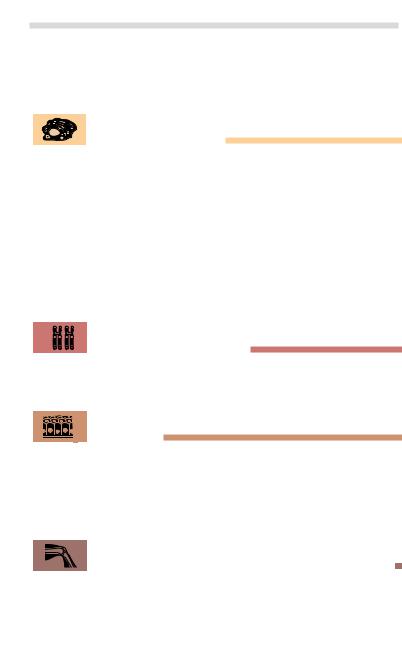
Contents VII
Contents
A more detailed table of contents can be found at the beginning of each chapter
1 |
Biology of the Cell |
1 |
|
Introduction . . . . . . . . . . . . . . . . . . . . . . . . . . . . . . . . . . . . . . . . . |
2 |
|
Number, Size, Shape, and Properties of Cells . . . . . . . . . . . . . . . |
2 |
|
Structure of the Cell and Cell Organelles . . . . . . . . . . . . . . . . . . |
4 |
|
Cell Division (Mitosis) . . . . . . . . . . . . . . . . . . . . . . . . . . . . . . . . . . |
18 |
|
Reduction or Maturation Division (Meiosis) . . . . . . . . . . . . . . . . |
21 |
|
Exchange of Materials between the Cell and Its Environment . . |
24 |
|
Membrane or Resting Potential of a Cell . . . . . . . . . . . . . . . . . . |
27 |
|
Solid and Fluid Transport . . . . . . . . . . . . . . . . . . . . . . . . . . . . . . . |
28 |
2 |
Genetics and Evolution |
39 |
|
Genetics (The Science of Heredity) . . . . . . . . . . . . . . . . . . . . . . . |
40 |
|
Evolution (The Science of Development; Phylogeny) . . . . . . . . . |
55 |
3 |
Tissues |
67 |
|
Epithelial Tissue . . . . . . . . . . . . . . . . . . . . . . . . . . . . . . . . . . . . . . . |
68 |
|
Connective and Supporting Tissues . . . . . . . . . . . . . . . . . . . . . . . |
72 |
|
Muscle Tissue . . . . . . . . . . . . . . . . . . . . . . . . . . . . . . . . . . . . . . . . |
85 |
|
Nerve Tissue . . . . . . . . . . . . . . . . . . . . . . . . . . . . . . . . . . . . . . . . . |
97 |
4 The Locomotor System (Musculoskeletal System) |
113 |
|
|
Axes, Planes, and Orientation . . . . . . . . . . . . . . . . . . . . . . . . . . . |
114 |
|
General Anatomy of the Locomotor System . . . . . . . . . . . . . . . |
116 |
|
Special Anatomy of the Locomotor System . . . . . . . . . . . . . . . . |
129 |
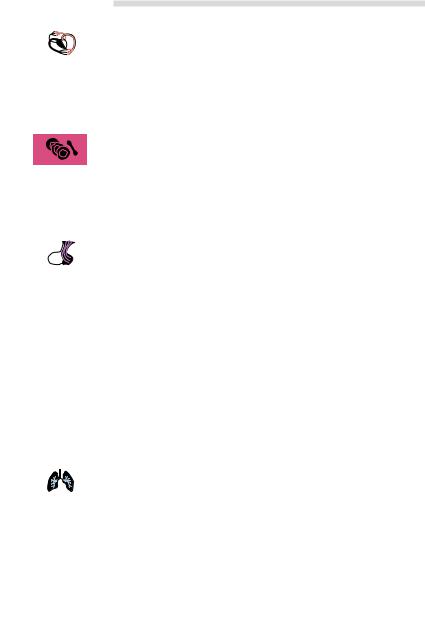
VIII Contents
|
5 The Heart and Blood Vessels |
|
205 |
|
|
||
|
|
|
|
The Heart (Cor) . . . . . . . . . . . . . . . . . . . . . . . . . . . . . . . . . . . . . . . 206
The Vascular System—Structure and Function . . . . . . . . . . . . . . 228
The Vascular System—Physiological Principles . . . . . . . . . . . . . . 244
6 Blood, the Immune System, and Lymphoid Organs  259
259
The Blood . . . . . . . . . . . . . . . . . . . . . . . . . . . . . . . . . . . . . . . . . . . 260
The Immune System . . . . . . . . . . . . . . . . . . . . . . . . . . . . . . . . . . . 282
The Lymphoid Organs (Immune Organs) . . . . . . . . . . . . . . . . . . 287
|
7 The Endocrine System |
|
307 |
|
|
Hormones . . . . . . . . . . . . . . . . . . . . . . . . . . . . . . . . . . . . . . . . . . . 309
Hypothalamic−Hypophyseal Axis . . . . . . . . . . . . . . . . . . . . . . . . . 313
Pituitary Gland (Hypophysis) . . . . . . . . . . . . . . . . . . . . . . . . . . . . 314
Pineal Gland (Pineal Body, Epiphysis Cerebri) . . . . . . . . . . . . . . . 317
Thyroid Gland . . . . . . . . . . . . . . . . . . . . . . . . . . . . . . . . . . . . . . . . 318
Adrenal Glands (Suprarenal Glands) . . . . . . . . . . . . . . . . . . . . . . 321
Islet Apparatus of the Pancreas . . . . . . . . . . . . . . . . . . . . . . . . . . 325
The Gonads . . . . . . . . . . . . . . . . . . . . . . . . . . . . . . . . . . . . . . . . . . 327
Other Tissues and Single Cells Secreting Hormones . . . . . . . . . 328
|
8 The Respiratory System |
|
333 |
|
|
||
|
|
|
|
The Path of Oxygen to the Cell: External and Internal
Respiration . . . . . . . . . . . . . . . . . . . . . . . . . . . . . . . . . . . . . . . . . . 334
Organs of the Air Passages . . . . . . . . . . . . . . . . . . . . . . . . . . . . . 335
Serous Cavities and Membranes of the Chest and Abdomen . . 348
Lungs (Pulmones) . . . . . . . . . . . . . . . . . . . . . . . . . . . . . . . . . . . . . 348
Ventilation of the Lungs . . . . . . . . . . . . . . . . . . . . . . . . . . . . . . . . 353
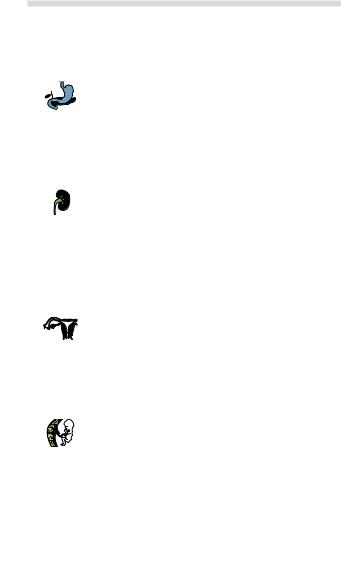
Contents IX
Gas Exchange and the Blood−Air Barrier . . . . . . . . . . . . . . . . . . . 357
The Regulation of Breathing . . . . . . . . . . . . . . . . . . . . . . . . . . . . 363
The Mechanics of Breathing . . . . . . . . . . . . . . . . . . . . . . . . . . . . . 365
|
9 The Digestive System |
|
377 |
|
|
Metabolism, Energy Requirements, and Nutrients . . . . . . . . . . . 378
The Digestive Organs . . . . . . . . . . . . . . . . . . . . . . . . . . . . . . . . . . 389
Overview of the Digestive Processes . . . . . . . . . . . . . . . . . . . . . . 428
|
10 The Kidneys and Urinary Tract |
|
441 |
|
|
Role of the Kidneys . . . . . . . . . . . . . . . . . . . . . . . . . . . . . . . . . . . . 442
Overview of the Structure and Function of the Kidneys . . . . . . 442
The Kidney (Ren, Nephros) . . . . . . . . . . . . . . . . . . . . . . . . . . . . . 443
Urinary Tract . . . . . . . . . . . . . . . . . . . . . . . . . . . . . . . . . . . . . . . . . 457
|
11 The Reproductive Organs |
|
471 |
|
|
||
|
|
|
|
Function and Structure of the Reproductive Organs . . . . . . . . . 472
Male Reproductive Organs . . . . . . . . . . . . . . . . . . . . . . . . . . . . . . 472
Female Reproductive Organs . . . . . . . . . . . . . . . . . . . . . . . . . . . . 485
|
12 Reproduction, Development, and Birth |
|
505 |
|
|
Germ Cells . . . . . . . . . . . . . . . . . . . . . . . . . . . . . . . . . . . . . . . . . . . 506
Fertilization . . . . . . . . . . . . . . . . . . . . . . . . . . . . . . . . . . . . . . . . . . 506
Transport through the Uterine Tube and Segmentation . . . . . . 511
Implantation and Development of the Placenta (Afterbirth) . . . 513
Development of the Embryo . . . . . . . . . . . . . . . . . . . . . . . . . . . . 516
Development of the Fetus . . . . . . . . . . . . . . . . . . . . . . . . . . . . . . 520
Birth . . . . . . . . . . . . . . . . . . . . . . . . . . . . . . . . . . . . . . . . . . . . . . . . 523
Postnatal Development . . . . . . . . . . . . . . . . . . . . . . . . . . . . . . . . 525
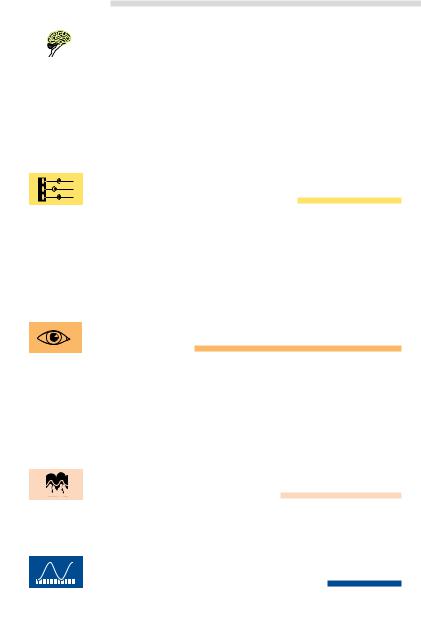
XContents
|
13 The Central and Peripheral Nervous Systems |
|
533 |
|
|
||
|
|
Classification of the Nervous System . . . . . . . . . . . . . . . . . . . . . 534
Role of the Nervous System . . . . . . . . . . . . . . . . . . . . . . . . . . . . . 534
Development of the Nervous System . . . . . . . . . . . . . . . . . . . . . 535
Central Nervous System . . . . . . . . . . . . . . . . . . . . . . . . . . . . . . . . 536
Peripheral Nervous System . . . . . . . . . . . . . . . . . . . . . . . . . . . . . 584
14 The Autonomic Nervous System |
605 |
Function and Components . . . . . . . . . . . . . . . . . . . . . . . . . . . . . . |
606 |
Outline of the System . . . . . . . . . . . . . . . . . . . . . . . . . . . . . . . . . |
608 |
Sympathetic Nervous System . . . . . . . . . . . . . . . . . . . . . . . . . . . |
609 |
Parasympathetic Nervous System . . . . . . . . . . . . . . . . . . . . . . . . |
613 |
Nervous System of the Intestinal Wall . . . . . . . . . . . . . . . . . . . . |
616 |
15 Sense Organs |
623 |
Receptors and Sensory Cells . . . . . . . . . . . . . . . . . . . . . . . . . . . . |
624 |
The Eye . . . . . . . . . . . . . . . . . . . . . . . . . . . . . . . . . . . . . . . . . . . . . |
625 |
The Ear . . . . . . . . . . . . . . . . . . . . . . . . . . . . . . . . . . . . . . . . . . . . . . |
644 |
The Sense of Taste . . . . . . . . . . . . . . . . . . . . . . . . . . . . . . . . . . . . |
654 |
The Sense of Smell . . . . . . . . . . . . . . . . . . . . . . . . . . . . . . . . . . . . |
655 |
16 The Skin and Its Appendages |
663 |
Skin (Cutis) and Subcutaneous Tissue (Tela Subcutanea) . . . . . |
664 |
Skin Appendages . . . . . . . . . . . . . . . . . . . . . . . . . . . . . . . . . . . . . |
668 |
17 Quantities and Units of Measurement |
673 |
Abbreviations . . . . . . . . . . . . . . . . . . . . . . . . . . . . . . . . . . . . . . . . |
674 |

A-Z
Contents XI
The SI System of Units . . . . . . . . . . . . . . . . . . . . . . . . . . . . . . . . . 674 Multiples and Fractions (Powers of Ten) . . . . . . . . . . . . . . . . . . . 675 Concentrations and Equivalent Values . . . . . . . . . . . . . . . . . . . . 677
Glossary |
|
679 |
|
|
|||
Index |
|
|
682 |
|
|
||
|
|
||
